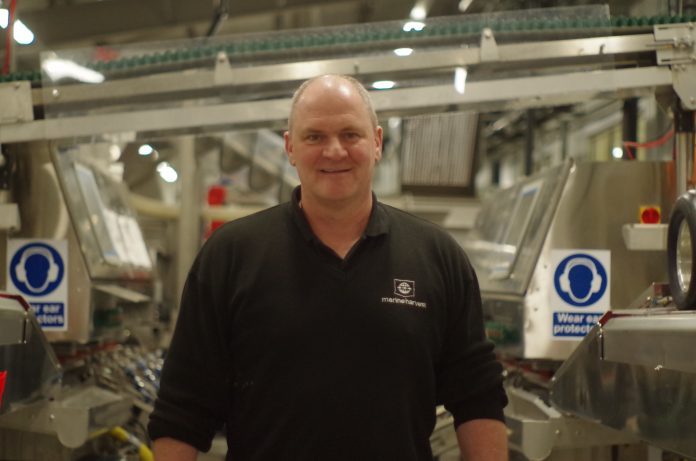Salmon at one of their critical stages of life at Mowi Scotland.
At Mowi’s recently opened Inchmore Hatchery at Glenmoriston, Scotland, the fry unit system was cleaned out but the scale of the operation was clear. Pipes curl in and out of huge tanks – while technicians keep everything in check. They, themselves are put through six months of training to work here.
On the visitors viewing area of Inchmore’s hatchery area manager Allan MacDonald explained in detail each section. Up to six million parr and six million smolts per year are to be produced in four massive batches, providing half of Mowi Scotland’s needs.

Alevins
Barely visible when pressed up glass were the tanks containing the yolk-sac fry or alevins.
“They’ve just had first feeding,” explained MacDonald. “We’ve reduced the light levels down to 15 per cent. If there is too much light, then they will go to the centre of the tanks.”
“The risk with too much light is that the small fish will hide in numbers, clump together and suffocate each other, so they are kept in the darkness,” said MacDonald. Each tank can roughly hold about 180,000. Some have only been feeding for five days.
Mowi’s Inchmore – one of the world’s most technically advanced water recirculating systems – is all about reducing as much stress for the fish as possible.

“The fish are so small, they weigh 0.2 of a gram. They are easily spooked but in time they’ll get used to human interaction and seeing people in time,” he said.
Around the tank there’s a black ring which diffuses oxygen. In the event of a power failure, the ring would still diffuse air in the tank to keep young fish alive.
At this stage, the fish are fed a high energy diet of fishmeal containing vitamins and minerals. “It’s very small, the feed is not from Kyleakin (Mowi Scotland’s GBP 125 million fish feed plant on the Isle of Skye)” he added. “We’ve got BioMar on two of the rircs and our flow through hatchery uses Skretting. It’s not a lot of diet for fish up to that size – maybe 2-3 tonnes a year, we would need for that.”

MacDonald explained that in the smolt tanks, a drum filter filters out the waste, which is then processed in a separate tank. This is then moved to a heavy sludge tank to used as a fertilizer in the fields. “It’s a very good fertiliser,” he smiled.
Feed
A blue pipe across the top of the smolt tank makes sure the fish are feed. “It just drops above their heads, there are lots of different designs, but this one lets the feed dribble above them. It allows for good distribution of the feed so nothing gets wasted and dropped outside the tank,” he said.
The automated feeding units automatically fill up the hopper as soon as the feed level goes below the sensor.
“On some of the older sites, the guys are still lifting bags of feed, it’s very manual. So when people complain here about a button not working, I’ll say well “what did you do before?” he laughed.

Land-based
Walking around Inchmore’s huge facilities, it’s clear that Mowi’s operation is huge – and this is only to look after the fish until they are ready to go to a Loch. But what about land-based salmon farms – like Miami’s Atlantic Sapphire?
The hatchery veteran, who has been with the salmon farmer for 18 years, thought carefully about the question before answering.
“Landbased, it’s two to three time the size of here,” said MacDonald. “There are so many things that can impact. It’s the power supply needed to run these big farms and how much water you are taking and reusing. Somewhere along the line, you are going to have to discharge that effluent. Also, a traditional sea farm may use 20 – 30 tonnes of feed a day at the height of their cycle, so with a land-based site and the waste that comes back out of that, how do you start processing that? It’s just the size, the scale of it all. What goes happens when it goes wrong? In the sea, there’s oxygen, water, temperature, the ph, everything. On land, you’ve got to give them everything.”


